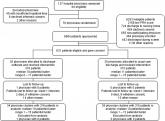Article

Patient and physician perceptions after software‐assisted hospital discharge: Cluster randomized trial
- Author:
- James F. Graumlich, MD
- Nancy L. Novotny, PhD
- G. Stephen Nace, MD
- Jean C. Aldag, PhD
Article

Patient readmissions, emergency visits, and adverse events after software‐assisted discharge from hospital: Cluster randomized trial
- Author:
- James F. Graumlich, MD
- Nancy L. Novotny, PhD
- G. Stephen Nace, MD
- Himangi Kaushal, MD
- Waleed Ibrahim‐Ali, MD
- Shoba Theivanayagam, MD
- L. William Scheibel, MD, ScD
- Jean C. Aldag, PhD
Article
Discharge planning scale: Community physicians' perspective
- Author:
- James F. Graumlich, MD
- Karen Grimmer‐Somers, PhD
- Jean C. Aldag, PhD
Article
Brief scale measuring patient preparedness for hospital discharge to home: Psychometric properties
- Author:
- James F. Graumlich, MD
- Nancy L. Novotny, PhD(c)
- Jean C. Aldag, PhD
